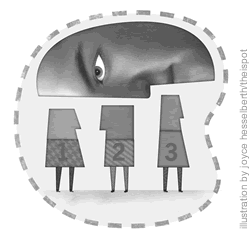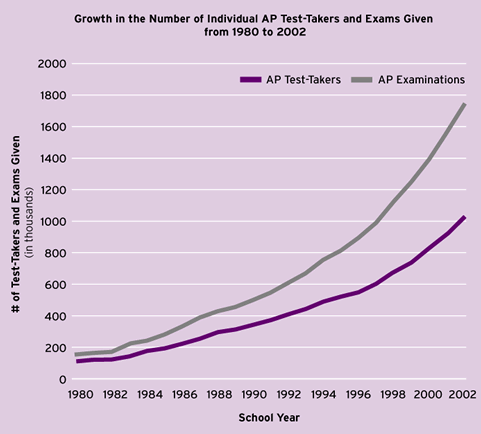
The practice that has come to be known as “tracking” began as a response to the influx of immigrant children into America’s schools during the early 20th century. To educate this newly diverse student population, school officials thought it necessary to sort children into different “tracks” based on their ability or past performance. As school reformer Ellwood P. Cubberley stated in 1909, “Our city schools will soon be forced to give up the exceedingly democratic idea that all are equal, and our society devoid of classes . . . and to begin a specialization of educational effort along many lines.” The advent of the IQ test and standardized achievement tests accelerated this trend by making the sorting process more apparently scientific.
In the early days of tracking, junior-high and high-school students were assigned to academic, general, or vocational tracks. At one extreme students were being groomed for college, while at the other they prepared to enter trades such as plumbing or secretarial work. By midcentury, a majority of secondary schools used some form of tracking. The practice was especially prevalent in large comprehensive high schools.
Today this extreme form of tracking is relatively rare. In the early 1970s, policymakers and educators, fearing that America was in danger of losing its competitive edge, began insisting that all students have access to a rigorous academic curriculum. States passed minimum graduation standards that required students to take a certain number of courses in the core subjects of English, mathematics, social studies, and science. And the 1983 A Nation at Risk report recommended even tougher standards. In the ensuing two decades, the percentage of students taking four years of each core academic subject increased dramatically.
With the new emphasis on preparing every student for college, tracking in its modern form has come to mean grouping students by ability within subjects. In each subject, students are assigned to advanced, regular, or basic courses depending on their past performance. For instance, students in the advanced track might take pre-calculus as juniors in high school and calculus as seniors, while students in the basic track might go only as far as algebra II or geometry. The creation and growth of Advanced Placement courses is perhaps the best example of how tracking has become an institutionalized practice (see Figure 1).
| AP Testing on the Rise (Figure 1) Advanced Placement (AP) courses represent an increasingly popular form of ability tracking. Since 1980, the number of students sitting for AP exams has increased more than sevenfold. The College Board estimates that just one-third of all students enrolled in AP courses actually sit for the exam. |
 |
| NOTE: The number of exams given exceeds the number of individual test-takers because test-takers may take exams in more than one subject. Totals include a small percentage of non-U.S. students. SOURCES: College Board; U.S. Department of Education |
The Backlash
Educators broadly support the practice of tracking in its modern form. Teachers find that tracking facilitates instruction by making it easier to gear lessons to the ability level of the whole class. Parents of high-performing students also favor tracking because research shows that students assigned to high-ability groups make greater gains in achievement. However, in studies published in 1986 and 1999, my colleagues and I found that students assigned to low-ability groups score lower on standardized tests than if they had been placed in mixed-ability or high-ability groups.
That finding lies at the core of a backlash against tracking that began in the 1980s. Critics argued that tracking, especially in practice, created greater learning opportunities for high-performing students at the expense of their lower-performing peers. Tracking’s opponents alleged that students in lower tracks often had the weakest teachers in a school, an unchallenging curriculum, few academic role models, and low social status. Moreover, they argued, tracking enabled educators to claim that courses were academic or college preparatory in nature when, in fact, the content lacked even the semblance of rigor.
The movement picked up considerable momentum with the 1985 publication of Jeannie Oakes’s deeply influential Keeping Track: How Schools Structure Inequality. Oakes provided empirical evidence of the disadvantages endured by students placed in lower tracks. In a similar vein, she revealed that some schools, under orders to desegregate, were promoting internal segregation by disproportionately assigning minority students to lower tracks. Overall, Oakes characterized tracking as an elitist practice that perpetuated the status quo by giving students from privileged families greater access to elite colleges and high-income careers. “Tracking is not in the best interests of most students,” Oakes concluded. “It does not appear to be related to either increasing academic achievement or promoting positive attitudes and behaviors. Poor and minority students seem to have suffered most from tracking—and these are the very students on whom so many educational hopes are pinned.”
At the height of the detracking movement, organizations including the National Governors Association, the National Education Association, the National Council of Teachers of English, and the California Department of Education came down in favor of detracking. Courts even mandated detracking reforms in some districts as part of efforts to desegregate the schools. For instance, in 1994 the San Jose Unified School District agreed to a consent decree that mandated detracking in grades K–9 and limited tracking in grades 10–12. But the response of school personnel was mixed. While many teachers favored detracking, a large number of parents, politicians, and other teachers resisted. As a result, while the schools became more integrated over time, and remedial classes were eliminated, detracking was never institutionalized as school practice.
Perhaps the most notorious episode in the detracking movement occurred in Massachusetts and California in the early 1990s. Officials in both states mandated that middle schools eliminate or reduce tracking. However, in The Tracking Wars: State Reform Meets School Policy, Brookings Institution scholar Tom Loveless demonstrated how schools, possessing a considerable degree of autonomy, were able to implement the new policy in ways that were consistent with local preferences. While neither state withdrew the mandate, the detracking movement could hardly claim victory.

Minor Inroads
To what extent has the detracking movement influenced the practices of schools and teachers? To date, no national longitudinal survey has provided solid information on the extensiveness of detracking and the manner in which it has been carried out. However, the National Educational Longitudinal Study of 1988 asked a representative sample of teachers whether students were assigned to classes comprising students who were above average, average, below average, or ranging widely in achievement. Their responses suggested that, nationwide, 15 percent of 8th-grade students were heterogeneously grouped for English classes, 14 percent for mathematics, 12 percent for science, and 18 percent for social studies. The remaining large majority of students were in classes with students of roughly the same ability level.
A second study, the Survey of High School Curricular Options, sampled 912 secondary schools in 1993 to obtain information about curriculum differentiation. It reported that 86 percent of high schools offered courses in which students were tracked. The data revealed that 14 percent of 10th graders took math courses in groups in which students’ abilities differed widely; the same was true for 28 percent of 10th graders in English.
A 2000 survey of all 174 public high schools in Maryland reported that two-thirds of the high schools used tracking in the four core subject areas, while 13 percent didn’t track students in any of the core subjects (the survey’s response rate was 79 percent). The remaining schools tracked in some but not all of the core areas. Interestingly, all of the 31 low-poverty, low-minority schools in the study used tracking, compared with only 36 percent of the 25 high-poverty, high-minority schools. In Maryland, at least, detracking is more likely in schools with a greater proportion of disadvantaged students. On the whole, however, the evidence suggests that the detracking movement has not transformed the way students are organized for instruction in America’s schools.
What explains the resilience of tracking? For one thing, teaching in a detracked school is far more difficult than in a tracked school. Teachers who have been assigned to detracked classes often report that they must “teach to the middle” or omit some of the curriculum because they don’t have time to instruct students at every different level within a class period. Moreover, detracking necessitates reallocating teachers and administrators, modifying the curriculum, and providing professional training. Schools may find these changes prohibitive for budgetary or logistical reasons. Finally, parents of high-ability students tend to prefer rigorous, homogeneous classes, while other parents are unconvinced that heterogeneous classes will benefit their children.

Subtle Influence
Despite widespread opposition to detracking and the failure of many efforts to institutionalize the policy, the detracking movement has had a major impact on school reform. While most schools still assign students to classes based on ability, the movement has heightened public awareness of the often inadequate resources and underwhelming curriculum provided to students in low-track classes.
Furthermore, the detracking movement has challenged widely held beliefs regarding the notion of “ability” and the role it plays in determining the kind of curriculum to which students will be exposed. More educators are now convinced that nearly all students are capable of mastering a challenging curriculum. New academic standards, state tests, and accountability requirements represent an effort to ensure that all students are given access to a rigorous curriculum. Detracking may never become widespread, but changes such as these are expected to improve the achievement of all students, particularly those who are ill served by the negative aspects of tracking as it is currently practiced.
Maureen T. Hallinan is a professor of sociology and director of the Center for Research on Educational Opportunity at the University of Notre Dame.


